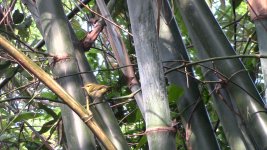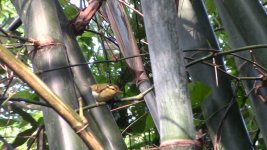I agree that this looks like it's Hartert's. It has fairly extensive yellow below, long bill, double wing bar and seems to have a rear crown stripe (although this isn't clear).
I don't have a lot of experience with Kloss's to compare. But as Grahame suggests, I'd expect them to look smaller-billed and to be whiter on the underparts.
Behaviour is often a good clue, that you can't pick up from the photos - Kloss's would normally be in the smaller twigs and leaves whereas Hartert's is usually among the larger branches, and often shows the 'nuthatch' behaviour of feeding on the sides of main trunks. But be warned that this isn't always the case, and Hartert's does sometimes feed in the canopy.
The exact extent of yellow on Hartert's is fairly variable - in my experience, most individuals of nominate goodsoni are brighter yellow below than this bird but there seems to be a lot of intergrades with whiter fohkiensis and it's not too unusual to have this combination of yellow face/supercilium, throat, breast and undertail coverts but whiter belly. I think that more work is needed on the regional variation between goodsoni and fohkiensis, and it's possible these may really be extremes of a cline rather than clear-cut subspecies.






